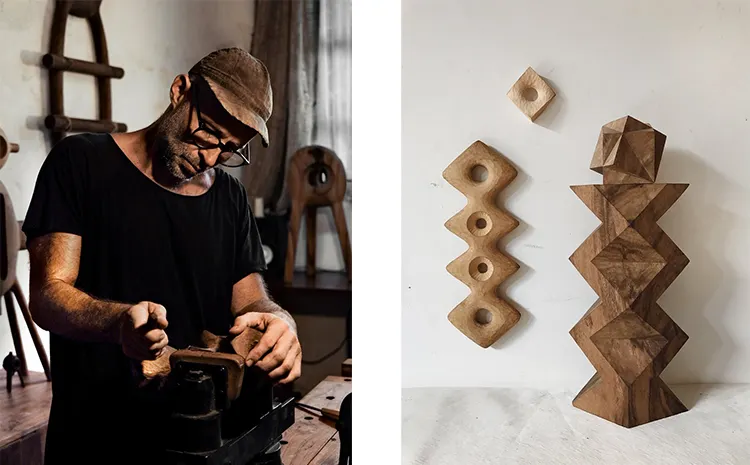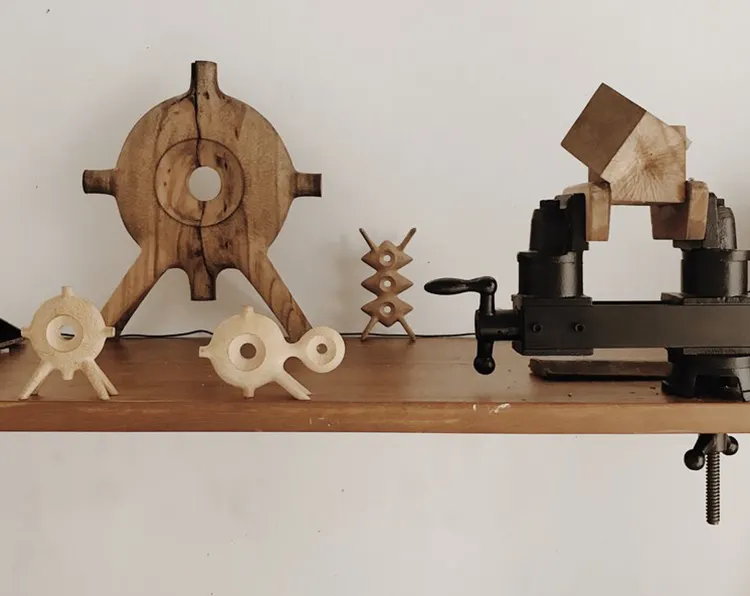A Legacy of Craftsmanship and Exploration
Aleph Geddis has carved out a distinct space in the world of contemporary sculpture, seamlessly merging traditional woodworking techniques with a modernist approach to form and balance. His wooden sculptures, marked by precision and a deep reverence for geometry, reflect a lifelong engagement with craftsmanship and artistic inquiry. Raised on Orcas Island in the Pacific Northwest, Geddis was immersed in the world of carving from an early age, learning the fundamentals from his stepfather, a sculptor and wooden boat builder. This formative exposure set the stage for his artistic evolution, which has since been defined by a pursuit of structural harmony and an ongoing dialogue between abstraction and natural form.
While Geddis’s artistic practice is deeply rooted in his upbringing, his work extends beyond personal heritage, drawing inspiration from a wide range of influences, including mid-century sculpture, West African art, and the mathematical precision of Platonic solids. His sculptures embody a tension between order and organic movement, revealing a meticulous understanding of how material and form interact. The interplay between structure and fluidity is a recurring theme in his work, with each piece serving as a meditation on balance—both physical and conceptual.
His process is an ongoing exploration, one that builds upon the knowledge passed down to him while pushing into new territory. Each sculpture carries echoes of his early training in traditional carving, yet his approach remains dynamic and ever-evolving. Whether creating large-scale commissions or smaller, intimate works, Geddis remains committed to his craft, ensuring that each piece resonates with the integrity and depth that have come to define his artistic voice.

Aleph Geddis: A Carving Tradition Reimagined
From his earliest encounters with wood as a child—fashioning playful objects in his stepfather’s carving shed—to his later studies of geometric structures, Geddis’s journey into sculpture has been both organic and deliberate. His education at a Waldorf school introduced him to sculpting with beeswax, an experience that reinforced an appreciation for process over permanence. This early lesson in transience continues to influence his approach, allowing him to embrace the evolving nature of his work rather than fixate on a predetermined outcome.
A pivotal moment arrived when he was 19 and participated in a carving class taught by his father. Discovering an innate talent for the craft, he transitioned into an apprenticeship, assisting with realistic depictions of flora and fauna. This period honed his technical abilities and instilled a disciplined approach to carving, yet his artistic curiosity soon led him beyond representational work. Drawn to the mathematical purity of Platonic solids, he began experimenting with geometric forms, exploring the ways in which rigid structures could be translated into wood while maintaining a sense of fluidity and movement.
Over time, his work has become increasingly abstract, yet it remains anchored in a deep respect for structural foundations. His sculptures are characterized by a refined interplay between sharp precision and the inherent warmth of wood, a balance that speaks to his dual influences of traditional craftsmanship and contemporary design. The act of carving itself—shaping a raw material with focused intention—remains central to his practice, offering both a meditative process and a means of articulating his evolving artistic language.

The Influence of Northwest Coast Native Art
Growing up in the Pacific Northwest, Geddis developed a profound appreciation for the region’s rich artistic heritage, particularly the carving traditions of Northwest Coast Native cultures. The stylized naturalism, symbolic storytelling, and distinctive use of compound curves left an indelible mark on his artistic sensibilities. Early in his career, he studied these carving techniques extensively, immersing himself in the structural logic and movement that define traditional Native sculptures.
The influence of this artistic lineage is evident in his own work, not only in the technical aspects of carving but also in the way his pieces convey a sense of dynamic energy. This connection became especially apparent in his commission for Filson’s flagship store in Seattle, where he created an 18.5-foot sculptural piece that paid homage to the Northwest Coast aesthetic while integrating his own geometric and abstract style. The project allowed him to bridge the past and present, drawing from historical traditions while continuing to refine his distinct artistic voice.
Beyond technique, what resonates most with Geddis about Northwest Coast art is its ability to capture movement within form. The interplay of convex and concave surfaces, the rhythm of repeating patterns—these elements parallel his own explorations into how geometric and organic shapes coexist. His sculptures, while not directly imitative, reflect a similar pursuit of harmony between precision and expression, a quality that continues to define his evolving body of work.

Aleph Geddis: The Pursuit of Artistic Integrity
While Geddis has established himself as a sought-after sculptor, his career has not been without its challenges. One of the most persistent struggles has been navigating the delicate balance between creative freedom and financial sustainability. Early in his career, working on commissions with his father sometimes left him feeling like a surrogate artist, executing someone else’s vision rather than his own. This experience instilled in him a commitment to only accepting projects that align with his artistic identity—pieces he would create regardless of external demand.
His influences extend beyond artistic traditions to the very philosophy of making. The discipline and precision he observed in artists such as Constantin Brancusi and Duane Pasco have informed his own approach, reinforcing the importance of meticulous craftsmanship and intentionality. Brancusi’s ability to distill forms to their essence and Pasco’s disciplined carving process both serve as guiding principles in Geddis’s work. Similarly, his fascination with West African textiles and Dogon masks speaks to his appreciation for distilled power in form—objects that communicate depth through simplicity.
At the core of Geddis’s practice is an unwavering dedication to the act of creation itself. In an age of digital distractions and rapid consumption, he finds solace in the physicality of his work—the rhythm of carving, the tactile engagement with wood, the meditative repetition of shaping material by hand. For him, the true reward of his practice lies in the process, a constant exploration of form, movement, and meaning that continues to shape both his art and his understanding of the world around him.

The post Aleph Geddis: Sculpting the Language of Form and Movement appeared first on AATONAU.
+ There are no comments
Add yours